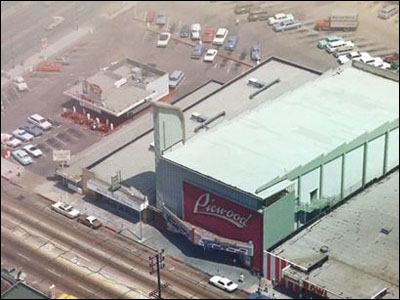I will soon be resuming a series of articles here under the title "Borders Crossing." Back in Part 5, I briefly told you about a market that was located near the corner of Westwood Boulevard and Pico Boulevard in West Los Angeles. That market was on the southeast corner of those cross streets. This one is about what was on or about the southwest corner. That intersection was within walking distance of where I grew up. In fact, when I went to University High School and later to U.C.L.A., I would sometimes wind up at bus stops at that intersection.
Located a door or three west of it was the Picwood Theater, a place that showed second-run (sometimes, first-run) movies. Here are the names of four movies that I'm quite sure I saw at the Picwood along with the years of their release, which is when I would have seen them there: Hey There, It's Yogi Bear! (1964), They Shoot Horses, Don't They? (1969), Willard (1971) and Fame (1980). There were many, many others.

The Picwood opened in 1948 and was demolished in 1985 to make way for a huge shopping center. An awful lot of my childhood and adolescence was demolished to make way for huge shopping centers. I fully expect that someday, I will be demolished to make way for a huge shopping center.
There are many photos around of the Picwood but for years, I was never able to find a photo of a little hamburger stand that sat on what was otherwise a huge parking lot at the corner of Pico and Westwood. It was called Scot's and it was one of three or four Scot's locations in Southern California.
Scot's was about as blatant an imitation of McDonald's as you could have opened without having Ray Kroc personally come by to swat you in the face with a subpoena. It had no clown. Its "mascot," who I believe existed only as a big painted sign on the roof of each Scot's, was a lovely lady wearing Scottish attire including a kilt. That and the name were the only things even vaguely Scottish about the place.
They did not serve haggis or porridge or stovies. They served the exact same things McDonald's served for lunch and dinner — very close imitations — plus pizza. As I recall, the pizza wasn't bad considering its price and point of origin. The burgers and fries were as good or bad as at McDonald's and the prices were the same. There was then no McDonald's anywhere nearby — there is now — so my family and friends went to Scot's often.
It did not last as long as the Picwood. I would say it was gone by 1970, replaced on that plot of land by one of the short-lived Lone Ranger restaurants. That chain — which you can read about here — appeared and disappeared in two or three years. I recall not particularly liking the food there but the design of the place was very cool and on the weekends, the Lone Ranger himself would appear in person at one of the four-or-five Lone Ranger restaurants in Southern California.
And when I say "the Lone Ranger himself," I don't mean some guy they hired to put on the mask and the outfit. It was the man, Clayton Moore, in all his glory. I wonder how many people who shook hands with him and got photos understood that it wasn't some guy they hired to put on the mask and the outfit.
Or how many didn't go because they didn't believe it would be Clayton Moore. I told my friend Mike Royer, who was a huge fan of the character and the man who played him on TV, and Mike was skeptical. But he went to one, met The Genuine Article, and ran home to phone me, as excited as if he'd met the actual Santa Claus and sat on his lap.
Getting back to Scot's: I still have never found a good photo of the place and several friends of mine who grew up in West L.A. say they've been searching for one forever. But I recently came across this aerial snapshot of the corner which won't show you much. If you click on it, you can zoom in a little on the only image of Scot's I've ever seen…
The area between Scot's and the Picwood housed a number of different businesses my family patronized. One — and I'm not sure if that's it in this photo — was a redemption center for Blue Chip Stamps, which were these stamps you got when you went to the market. You pasted them in books and when you had enough books filled, you could take them to the redemption center and trade them in for some semi-valuable item. That was how and where my mother got me my first typewriter (an Olivetti-Underwood) and a copy of The Random House Unabridged Dictionary.
So you could kind of say my writing career started there. I still have both the typewriter and the dictionary. I haven't used the typewriter since I got my first electric one and I haven't looked a word up in that dictionary since I first got access to The Internet.
The businesses on the other corners of Pico and Westwood weren't near as interesting. I won't be writing about them.
